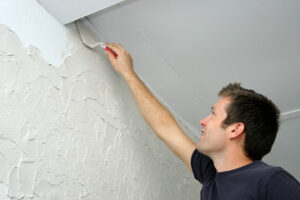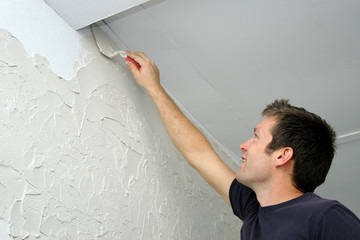Drywall Repair is a project most homeowners will have to tackle at one time or another. It can range from small holes caused by doorknobs to cracks from a settling foundation. To learn more about how professional drywall repairs can help you restore your home, contact the experts at Drywall Repair Las Vegas. They can answer any questions you may have and can provide a free estimate for your project.
 A drywall patch kit will cover holes up to four inches across, but you’ll need support boards for larger areas. These are installed inside the hole on either side and prevent the patch from collapsing into the wall.
A drywall patch kit will cover holes up to four inches across, but you’ll need support boards for larger areas. These are installed inside the hole on either side and prevent the patch from collapsing into the wall.
When cracks show up in drywall, it can be frustrating. The problem is usually on a seam where two pieces meet. Piquing these cracks using a drywall knife, putty, and sandpaper is easy enough. The sanding step takes some practice, but you can get a smooth surface ready for paint with patience.
Cracks in drywall are often caused by normal expansion and contraction of the material or by structural movement in the building. Typically, these cracks are minor and cosmetic in nature. They may even disappear on their own in a few months. However, they should be repaired to prevent them from reappearing.
In addition to a utility knife and sandpaper, you’ll need a box of fiberglass mesh drywall tape, patch compound or drywall mud and primer. This material is available at most hardware and home improvement stores. Some products also combine the compound and primer in one product. Regardless of which type of material you purchase, read the label carefully to ensure you’re getting the best product for your project.
Most drywall cracks are cosmetic and are easily repaired. Often, these cracks appear outside a wall and can be fixed by simply putting down a fresh coat of drywall compound over the damaged area. The only exception is when a nail or screw pops through the drywall surface and shows through the finished paint. In this case, you’ll need to counter-sink the nail or screw. This will make the nail or screwless likely to protrude through the drywall again.
It’s also common for a home to settle over time, which can cause cracking in the inside corners of the room. The settling is usually gradual and isn’t a serious issue. However, if the house was built on a fill dirt foundation, the settlement can be more dramatic and cause stress cracks.
Inside corner cracks can be repaired by applying a small amount of setting compound to the wall surface. Then, apply a strip of drywall tape over the seam. The tape will bridge the gap between the ends of the compound and reinforce the seam. Next, apply a thin coat of joint compound over the tape and let it dry. After the compound is dry, lightly sand it with a fine-grit sanding sponge. Then, prime and paint the spot.
Holes
If you’re dealing with a hole the size of a doorknob or smaller, there are several ways to go about it. Some patch kits include a type of mesh that’s self-adhesive; just peel and stick it to the wall, overlapping the edge on all sides by about 1 1/2 inches. You’ll also need a container of pre-mixed joint compound (also known as mud) and 6-inch and 12-inch metal putty knives, says Nungesser.
To do the job yourself, first clean away any dust or debris around the hole, then lightly tap the wall with the rounded end of a screwdriver or hammer to create a slight depression. That helps make the patch look more invisible when painted over. Then fill the depression with a thin coat of joint compound, sand it smooth and apply additional coats as needed.
Be sure to wear a mask when working with drywall compound; inhaling too much of it can damage your lungs. Also be sure to sand between coats, or you’ll end up with bumps and ridges that will stand out like a sore thumb when the walls are repainted.
Larger holes require more than just spackle or drywall compound; you’ll also need some mesh drywall tape. Cut a piece of drywall that’s about 2 inches larger than the hole in both width and height, then apply the tape to the edges. The tape helps strengthen the repair, reduce shifting during and after painting and help prevent future cracks.
Once the drywall patch is in place, cover it with a second layer of joint compound and use a putty knife to smooth it over the patch and tape. Then, sand the entire surface to help it blend with the existing wall. Once the drywall patch is smooth, consider priming and repainting the entire wall to help the new spot match the rest of the color.
If you’re tackling a bigger hole, be sure to verify that electrical cords and plumbing lines aren’t running through it before cutting into the wall. That way you can avoid having to repair or replace any wiring down the road. And don’t forget to save a bit of the old drywall for reuse when you need more than just one small patch.
Moisture Damage
Drywall is a relatively resilient material, but moisture can damage it and create other problems in your home or business. If your drywall is damaged by water, you must have it repaired quickly to avoid serious structural damage and mold growth.
Most water damage is obvious, such as visible water stains or bubbling in the drywall or ceiling. If you see these signs, call a professional immediately to schedule a drywall restoration service. In some cases, the drywall may need to be replaced completely.
If the drywall is only slightly water damaged, you can repair it using a patch kit or other simple techniques. Patch kits are designed to fix holes that are about the size of a doorknob or smaller. They come with a self-adhesive mesh patch that sticks to the drywall and covers the hole. It is important to clean the drywall thoroughly before applying the patch to prevent mold or mildew growth.
Larger drywall holes require more extensive repairs. Cut out the damaged section of drywall, if possible, and remove any insulation that may be behind it. If the damaged drywall exposes wall studs or ceiling joists, it may be possible to anchor a replacement panel to these supports. If not, the entire piece of drywall will need to be replaced.
After repairing the hole, you will need to sand the area smooth and apply a coat of sealant to protect it from further damage. You should use a bucket that has drainage holes or a dual-cartridge respirator to avoid inhaling drywall dust, which contains fine gypsum and silica particulates.
Moisture is a problem for drywall even when the damage is not severe, because it can cause a variety of other issues, from warping to the growth of mildew and mold. Fortunately, you can minimize moisture damage in your drywall by cleaning up any spills as soon as they happen, and by keeping your gutters clear of debris. It is also a good idea to keep an eye on your roof and gutters to make sure they are not leaking or clogged.
Texture
When repairing drywall that is already textured, a skilled tradesman will take special care to ensure that the patch is seamless. This step is sometimes overlooked because it’s the least noticeable, but it can make or break whether the texture matches the rest of the wall.
Drywall texture can be created in a number of ways and there are many different textures used in homes today. It’s important to know how the original texture was created before trying to repair it. Tradesmen with years of experience can look at a texture and quickly determine what methods were used to apply it. For the most accurate repair, you’ll need to use similar techniques.
For example, if you have orange peel texture on your walls, it can be repaired using similar techniques. First, apply a skim coat of joint compound to the patch and feather it out. Once it’s fully dried, lightly sand and prime the area.
Next, apply a light coat of spray texture to the patch. When applying the spray, you’ll need to stand 3 to 4 feet away from the wall and move the gun in a sweeping motion. This method of repair is most suitable for small patches and can be done with oil-based or new water-based aerosol texture products.
If you have a larger repair to do and need to use a hand-held texture machine, prepare the worksite by putting on eye protection and covering any surrounding furniture with plastic drop cloths. Sanding drywall compound creates fine dust that can infiltrate any nearby items, so it’s best to protect them.
It’s also a good idea to practice this technique on scrap pieces of wallboard before you attempt it on your actual walls. If you do it correctly, you should be able to blend the patch in with your existing texture and no one will even know there’s a repair!
